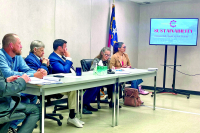The face of the shutdown: Local childcare centers teetering as shutdown interrupts funding
 All Nicole Smith could do last week was try to keep the doors open.
All Nicole Smith could do last week was try to keep the doors open.
Either the shutdown of the federal government would end, or North Carolina officials would tell her they don’t have the million of dollars necessary to cover childcare costs for needy infants and toddlers in the state, some of whom spend their days at her small center in Waynesville.
Although Creative Beginnings Child Development Center is a privately owned center in Waynesville, more than half of the 36 children in Smith’s care are on subsidies. Without that federal help, parents couldn’t or would struggle to pay for professional childcare. By extension, if half her clients leave, Smith would have trouble paying her employees and bills.
“I would definitely have to let employees go,” Smith said, adding that it would be “next to impossible” to stay open. “I would try.”
Many people who benefit from government subsidies — whether directly or indirectly, such as Smith — have spent more than two weeks wondering when and if the money they need will stop. North Carolina officials issued letters to counties on Oct. 14, saying that between leftover federal monies and funding from the state, there is enough money to cover part of this month. How many days’ expenses it will pay for, however, will vary county to county, according to state officials.
For Haywood County, the money is expected to stretch until Oct. 31, but for others, like Jackson County, it won’t.
Related Items
More than two weeks ago, when a partial government shutdown ensued, federal subsidies for the poor stopped. Not all of them, but several key funds would cease, including Childcare Development Block Grants, which help the poor pay for childcare.
But the state is still finding extra money left in its couch cushions to help cover some programs until Nov. 1. It is hoped the government shutdown will be over by then. Much is still unknown regarding the full impact of the shutdown on subsidy programs, even to those who work with them every day. Leaders with the counties and nonprofits can only try to stay ahead as the situation changes, sometimes hourly.
“We are talking to the state on a daily basis until we have definite information,” said Sheila Hoyle, executive director at Southwestern Child Development Commission, which allocates the federal childcare subsidies to childcare centers in this region. “We are watching the news daily hoping for a break there.”
One thing that’s for sure is that without the childcare subsidies, parents would need to find the money to pay for the service themselves, or more likely than not take off work or find a relative to watch their kids.
“What a tragic loss this is for our young families,” Hoyle said last week. “Their jobs will be at risk or they may have to drop out of school for the semester.”
Smith has already seen parents forced to take their children out of childcare centers because their family is still sitting on a government waiting list to receive childcare subsidies, and now, even more may be taken out of the system when all the subsidy money dries up this month.
Smith tries to keep her rates low and works with struggling parents on payment plans, but sometimes that’s not enough.
“Parents can’t pay,” Smith said. “They take (their children) out owing money, or they bring them back when they have the money.”
Another issue is that childcare costs have increased, but subsidy payments have not, meaning it is not enough to cover costs. Childcare providers have to decide whether to eat the difference or pass it on to the struggling parents.
“Am I going to charge this parent $200 who probably can’t afford it?” Smith said.
The government tends to undervalue early childhood care, said Smith, which nowadays is less like babysitting and more like preschool. Childcare center workers have to create lesson plans and the facilities are strictly monitored. Yet, Smith said, the amount of money available isn’t enough.
“It has prevented my teachers from getting raises and bonuses they deserve,” Smith said.
Financing the deficit
Prior to Monday afternoon, it was still unclear how much money North Carolina has for its Childcare Development Block Grant fund, which helps pay for childcare for needy families. So counties were asked to pitch in from local coffers. While most officials believe that the federal government will reimburse counties once the shutdown ends, there is not a guarantee.
“They have not given us exact guidance yet as what fund they might have,” said Hoyle last week.
Counties will still have to decide how to allocate the money the state is doling out to cover part of this month’s subsidies and once that runs out, whether to pay for childcare subsidies themselves.
There is a problem with shifting all the expenses onto counties during the shutdown, particularly these days, said Ira Dove, director of the Haywood County Department of Social Services. Over time, the state and federal government have forced counties to invest more and more in social services.
“At this point, the county has quite a bit of money in the system,” he said. “When something like this happens, the ability to extend additional dollars is harder than it might be otherwise.”
At least 23 of the state’s 100 counties had suspended payments for childcare as of Friday.
Swain County suspended its childcare subsidy payments Monday. The county paid $7,500 to ensure that childcare facilities remained open last Thursday and Friday, which gave parents time to find an alternative childcare option.
“I just hate it for the families,” said Sheila Sutton, interim director of Swain County DSS, at a meeting of the county commissioners last week.
However, now that additional funding was found at the state level, childcare centers in Swain County are open and parents are receiving the subsidies they need to keep them enrolled. When the money is gone though, the counties must choose whether to find more funding in their own coffers or suspend childcare subsidies — that is unless the shutdown has ceased.
Childcare centers could still operate, but only on the understanding that they would not receive any subsidies once the state allocation is used, and they would not necessarily receive retroactive reimbursements once it ends.
Haywood, Macon and Jackson counties waited to see if there was any update from the state or if the federal shutdown will pass soon before making any decisions, which seems to have paid off for now.
The state believes it is likely that the federal government will retroactively pay out subsidies, but there is a chance that bet could backfire if Congress approves a spending bill that purposely leaves out back pay. This leaves counties in a quandary.
“How long do they allow it to go on with the possibility that the county is responsible for paying for it?” said Robert Cochran, director of Jackson County DSS, last week.
Unsurprisingly, counties do not have the resources available to states and the federal government. Jackson County alone receives $169,000 a month in federal money for the programs affected by the shutdown.
“It would be very difficult for individual counties such as Jackson County to replace,” Cochran said. “How far can we stretch county dollars?”
North Carolina has its own early childhood education program, Smart Start, which also offers childcare subsidies to qualified families. Some of the Smart Start money will now pay for some children who typically receive federal childcare subsidies, but not everyone.
“The Smart Start funding stream is smaller than the federal funds,” Hoyle said. “We would not have Smart Start funds to cover every child.”
An Oct. 3 letter from the N.C. Department of Health and Human Services instructed county departments of social services to minimize the impact of the lost funds by freezing vacant position, reducing service levels, furloughing staff and cutting back on purchases and travel. Each county DSS director must make those decisions based on their local needs.
“Do we shutdown? Do we have partial furloughs? Do we ask staff to work on the promise of a future paycheck? Do they work part-time?” Cochran said.
Haywood County DSS has not furloughed anyone yet, but it has frozen four unfilled positions to keep budgets tight during the shutdown. Dove said the department would fill those jobs otherwise, and keeping them open means fewer workers to help those in need.
“It reduces our capacity to provide services,” Dove said.
Services not provided
Besides childcare subsidies, other programs affected by the shutdown include Work First, adult and child protective services, energy assistance programs and the Special Supplemental Nutrition Program for Women, Infants and Children (WIC).
“It’s going to be a pretty widespread impact on seniors and children and the least among us,” Dove said.
For mothers in WIC, the last week was been down and up. First, the N.C. Department of Health and Human Services stopped handing out food vouchers on Oct. 8. The department said it did not have enough money to cover the expense without funds from the federal government. But two days later, the state announced it had found enough money to continue paying for WIC throughout the month of October, meaning mothers and children would not have to go without aid.
About $550,000 in food is purchased with WIC vouchers every day in the state, amounting to about $17 million spent in the state’s grocery stores during the month of October.
Still to combat a rise in demand at food banks in the state, retail giant Food Lion donated $500,000 in gift cards to various pantries. N.C. Gov. Pat McCrory also issued a statement Monday committing $750,000 in state funds to seven regional food banks, including MANNA food bank, which serves 16 counties in Western North Carolina.
The Low Income Home Energy Assistance Program, or LIHEAP, which helps pay for heating bills, has not been affected by the federal shutdown. Money from that program is not disbursed this early in the year. Plus, the region is experiencing relatively warm weather.
“We are fortunate it has been temperate so far,” Dove said.
However, should the temperature drop, the counties would have to foot the bill to ensure that the poor and elderly aren’t left out in the cold.
Although people who were already signed up for Work First will get their benefits this month, county departments of social services cannot process any new program applications. Work First provides help to individuals and families as long as the parent or parents are working or actively searching for employment.
As of Oct. 15 — since the shutdown was still in place — the state Department of Health and Human Services started working with county DSS offices on a plan to let Work First recipients know that they may not receive a check in November.
DSS offices throughout the state were already struggling to keep up with all the program applications as it was, but now that none can be processed during the shutdown, the backlog of paperwork will continue to pile up and delay people from receiving the help they need.
U.S. Rep. Mark Meadows, R-Cashiers, has taken flack nationally for his perceived role in the federal shutdown. The New York Times and CNN published lengthy articles stating that Meadows led a movement to pressure U.S. House Speaker John Boehner, R-Ohio, to use the shutdown as leverage in an ongoing battle against “Obamacare.”
While some of his constituents support Meadows’ stance, Peggy Wallace, a 64-year-old Waynesville resident, thinks he should stand down.
“He has already done enough harm with what he has already done,” Wallace said, adding that the needy are suffering despite the fact that the federal government had the money to help them.
But like the counties, small-time nonprofits don’t have the resources to help everyone.
“The thing that bothers me is they don’t realize most of these organizations that operate in the community are small and rely on the community,” Wallace said.
By the numbers
The Southwestern Child Development Commission, which distributes federal childcare subsidies, serves 2,000 children in the seven westernmost counties of North Carolina. Each child has been affected by the uncertainty surrounding the federal government shutdown, which has temporarily cut off funding for childcare.
Children receiving childcare subsidies:
Haywood County: 586
Jackson County: 338
Macon County: 424
Swain County: 199
Depending on the number of children and how many days they attend a childcare center, each county receives a different amount of federal funding to help offset the costs of childcare.
Haywood County: $250,000
Jackson County: $130,000
Macon County: $97,800
Swain County: $63,000
On Oct. 14, the North Carolina Department of Health and Human Services sent letters to counties stating that it had found enough money to partially fund childcare subsidies that are usually paid for by the federal government in October. The following is how much each county has to work with to cover October and September:
Haywood County: $447,629
Jackson County: $296,796
Macon County: $168,460
Swain County: $127,698








